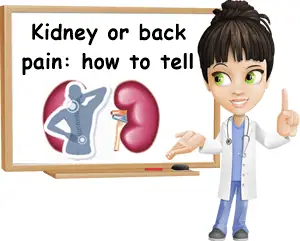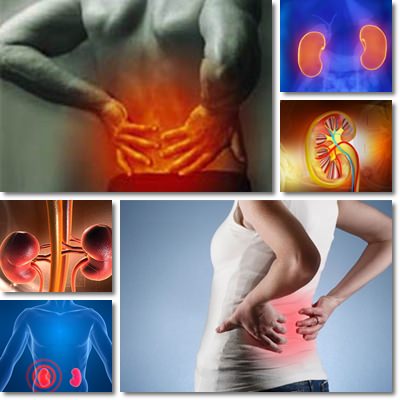The first thing you think about when you experience lower back pain is if it’s kidney pain or actual back pain. A lot of times it’s hard to tell the difference between the two because they can be so similar. It’s also possible that it starts as one and becomes the other, further contributing to the difficulty in distinguishing between different types of lower back pain. Just location of the pain is not always relevant in determining whether it’s kidney or back pain mainly because it can sometimes be hard to actually locate the pain which can radiate to nearby areas. Lastly, it’s also important to make a difference between kidney pain, muscle pain and pain coming from the spine and vertebrae or nerves.
Kidney pain or back pain: how to tell the difference? You can tell the difference between kidney pain and lower back pain based on various characteristics of the pain and other symptoms associated with it as well as triggers and response to pain relief therapies. In my experience, you only need to have had one of the two to be able to tell them apart extremely well.

1) Kidney pain is usually located laterally, on the sides, between the ribs and hips, directed more towards the back. It can be felt either on one side of the back or on both the left and right side at the same time, depending on whether one or both kidneys are affected. When severe, pain radiates to the lower abdomen or upwards at the base of the ribs.
2) Back pain can affect any area of the back, but usually only lower back pain can be confused with kidney pain. Lower back pain doesn’t usually occur at the sides of the back, between the ribs and hips. That is almost always kidney pain. But if there is a muscle strain or injury to the back muscles at the sides, the pain should be located lower in the back, further away from the base of the ribs. If the pain is located right under the ribs and is felt deeper, then it’s kidney pain.
Lower back pain can come from muscle strains, exposure to cold or low temperatures, pinched nerves, joint inflammation, arthritis of the spine, vertebrae, bone infections, osteoporosis with fractures, bone frame abnormalities such as a curved spine or more serious conditions.
You can tell what the cause of the lower back pain is based on the location and characteristics of the pain. For example, if the lower back pain continues in the thigh, leg or foot, accompanied by numbness, weakness or tingling sensation, it’s possible it’s sciatica affecting the sciatic nerve going from the lower back to the foot. Pain localized in the lower back, but responsive to movement, fluctuating in intensity likely originates in the muscles and can be a result of a muscle strain, tear or other muscle injury. If the spine, vertebrae, other bones or joints of the back are affected, the pain is not continual, but rather reactive to certain movements and tends to restrict normal range of motion. Posture may be affected as well.

3) Kidney pain is almost always intense and remains steady even as you change position or try to massage the area, apply heat or seek similar forms of relief. It is also felt as an inside pain, located deeper beneath the muscles and higher up, closer to the base of the ribs.
4) Lower back pain is responsive to movement and can improve or get worse as you change position. To a certain extent, this is true for pain originating in muscle, bone and nerves.
5) Kidney pain can take many forms, from a slow-building, dull pain to sharp, acute and quite severe pain that becomes worse as the underlying kidney problem aggravates. Either one or both sides of the back hurt.
6) Back pain is usually pulsating or dull when the muscles are affected or comes in sharp bouts of pain when the spine or nerves are affected, depending on range of movement.
7) Kidney pain does not usually respond to alternative therapies, only to proper treatment of the underlying cause.
8) Back pain tends to respond well to rest, applying heat pads, use of infrared lamp (see benefits of infrared lamp), massage and anti-inflammatory medication. If the underlying causes are serious (tumors, bone fractures, bone infections etc.), proper medication targeting the specific underlying condition is needed.
9) Kidney pain symptoms. Cloudy urine or a red-colored urine indicating the presence of blood are signs of kidney stones, infection, inflammation, sometimes tumors. Nausea and vomiting are signs of either kidney stones or kidney infections. Fever and sweating occurring together with back pain often indicates a kidney problem, usually a kidney infection, rarely a mass. Burning sensation, strong, sharp pain that lasts for hours at a time followed by passing stones (visible or not) are symptoms of kidney stones. Swelling on one side that causes the kidney to be felt is a symptoms of blockage.
10) Back pain and associated symptoms. Localized pain, tenderness, bruising occur as a result of back injury. Tenderness and pain made worse of moving could be caused by muscle strains. Stiffness, chronic, low-grade pain and limited range of movement with periods of flare ups are potential symptoms of arthritis, often osteoarthritis. Numbness, weakness, tingling, loss of feeling in portions of the back throughout the length of the leg are often symptoms of sciatica. Paralysis occurs with fractures.
It’s not easy to distinguish between kidney pain and back pain and symptoms don’t always tell you the real cause behind the pain. This is why it’s important to always see your doctor. Symptoms such as cloudy urine or the presence of blood, swelling in one side of the body, fever, sweating, nausea, vomiting, inability to eliminate fluids, weakness, abnormal tingling, pins and needle or other similar sensations running along the length of the leg should urge your to seek medical advice as soon as possible. Especially when it’s a kidney related-pain, chances are you are either dealing with an infection and need antibiotics or have kidney stones and may require medical assistance.
Conclusion
Overall, the main differences between kidney pain and back pain are:
1) Kidney pain is lateral, radiating in the back. It is located higher up, at the base of the ribs (also called flank pain). Lower back pain typically only affects the back.
2) Kidney pain can radiate to the lower abdominal area, sometimes thighs. Back pain can continue along the leg, especially if it’s sciatica, or affect other parts of the lower back.
3) Kidney pain often presents with symptoms such as cloudy urine, difficulty and pain when eliminating liquids, nausea, vomiting (kidney stones), fever and sweating (kidney infection). Back pain is more likely to cause limited range of movement, numbness, weakness or tingling sensation.
4) Kidney pain does not improve or change in intensity when you move. Back pain can improve when you change position, move and when you rest. It also responds to heat therapy such as use of infrared lamps or massage.
